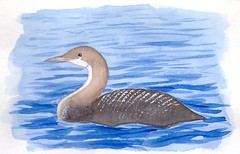 Do you ever wonder how birds (and many others) make long migrations, based on instinct alone? How they know where to go is a question I can't even begin to answer but how they know when they've got there - I sort of think I know how they feel, maybe. I'll explain - my dad is from Norfolk, but I was born in Bedford and never lived in Norfolk. However, in the last 10 years, I've often holidayed in Norfolk and I can't put my finger on it but it always feels like home, perhaps it's genetic, perhaps the 'Norf-folk' are just good at making you feel at home, perhaps I'm just a wishful townie. If nothing else, I reckon I understand the chiffchaffs that turn up in the poplars at the back of the house, each April, just that little bit better.
Do you ever wonder how birds (and many others) make long migrations, based on instinct alone? How they know where to go is a question I can't even begin to answer but how they know when they've got there - I sort of think I know how they feel, maybe. I'll explain - my dad is from Norfolk, but I was born in Bedford and never lived in Norfolk. However, in the last 10 years, I've often holidayed in Norfolk and I can't put my finger on it but it always feels like home, perhaps it's genetic, perhaps the 'Norf-folk' are just good at making you feel at home, perhaps I'm just a wishful townie. If nothing else, I reckon I understand the chiffchaffs that turn up in the poplars at the back of the house, each April, just that little bit better.Anyway, we spent last week in Wells-next-the-sea. What a lovely week, we got soaked in a boat out to see the seals and all got nasty coughs and colds but big skies and wide empty beaches were just so good for the soul that the mental repair was worth it at almost any price. Daily crab-lining and long afternoon naps helped too.
The top sketch is of the channel that runs from the quay, out to Wells Bar, and the black dot near the shore is a common seal's head. The bottom sketch is the birds we saw on our trip to Blakeney Point and, as it turned out, were our almost constant companions wherever we were all week.



